
Author: Natalie Ng|Updated: 5 June 2025
If you’re taking GLP-1 medications or thinking about them as part of your weight loss plan, what you eat still plays a big role. The right foods can help you stay full longer, support healthy digestion, and make it easier to manage blood sugar levels. Eating well also means making sure your body gets enough fuel and protein to maintain muscle mass while losing weight. That balance is important—especially if you're trying to burn fat without feeling low on energy or constantly hungry. There are certain GLP-1 weight loss foods that work well with these medications and support your overall health. They’re simple, everyday foods that are high in nutrients, gentle on blood sugar, and keep you feeling satisfied. Curious what to add to your meals? Keep reading—we’ll break down the best foods to help you stay on track and feel your best along the way.

GLP-1 Weight Loss Food 1: Green Vegetables
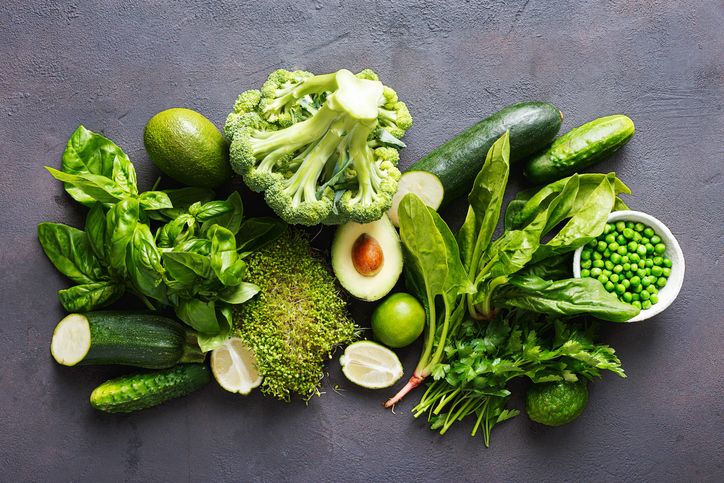
Green vegetables help stimulate natural GLP-1 release
While many people focus on supplements or medications to support GLP-1, green vegetables can naturally trigger this satiety hormone. High-fiber greens like spinach, kale, and broccoli slow digestion and support GLP-1 production in the gut. This helps food stay in the stomach longer, which increases fullness and lowers blood sugar after meals. Over time, this can reduce cravings and help manage weight more effectively.
Raw or lightly steamed greens improve satiety
You'll get the most benefit from leafy greens when you eat them raw or lightly steamed. Try adding a large serving of mixed greens to both lunch and dinner. Vegetables like Brussels sprouts, asparagus, and collard greens are also great choices. They contain high fiber and support digestive health, making them excellent GLP-1 weight loss foods.
To maximize satiety, aim for 2 to 3 cups of green vegetables daily. One simple strategy is to start your meals with a green salad. Eating greens first helps slow gastric emptying, which means food stays in your stomach longer. This may help reduce overall intake by controlling portion sizes and supporting better eating habits during the rest of your meal.

GLP-1 Weight Loss Food 2: Lean Proteins That Help Maintain Muscle
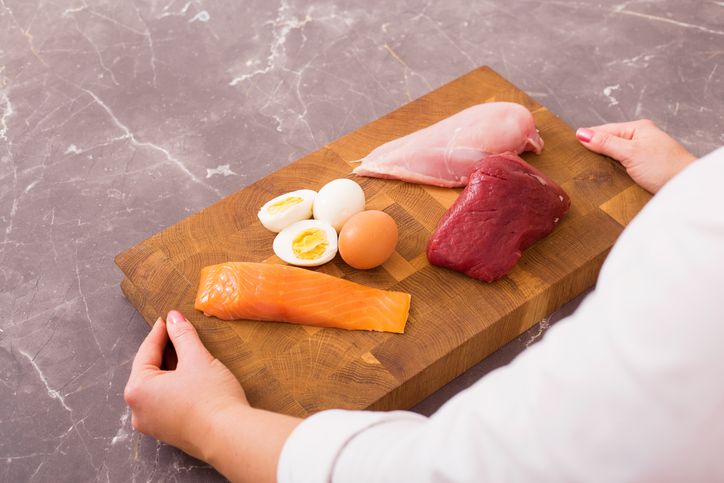
Lean proteins support fullness and preserve muscle mass
Lean protein sources can help increase GLP-1 levels while also preventing muscle loss during weight loss. Protein slows digestion and supports stable blood sugar, which helps reduce hunger and supports long-term weight management.
You can include skinless chicken breast, lean cuts of turkey, fish like salmon and cod, and egg whites in your meals. These are high-protein, low-fat foods that fit well into a balanced diet.
Protein triggers GLP-1 and supports appetite control
Protein-rich foods help trigger the release of GLP-1, which sends fullness signals to your brain. This effect reduces appetite and helps food stay in the stomach longer, contributing to fewer cravings and better portion control.
Greek yogurt and cottage cheese make effective high-protein snacks
Including protein at each meal and in between can help stabilize blood sugar levels throughout the day. Options like Greek yogurt and cottage cheese are excellent for snacks. They’re convenient, low in sugar (if unsweetened), and help prevent energy dips.
Fish also provides omega-3 fatty acids, which may enhance the effect of GLP-1. Omega-3s also support overall health and proper hormone function during your weight loss journey.
Ideal protein amounts to support muscle and digestion
To support muscle mass and stimulate GLP-1 effectively, aim for about 25 to 30 grams of protein per meal. This also increases your calorie burn since protein takes more energy to digest compared to carbs or fats. Including protein in each meal helps you meet your nutritional needs while improving your eating habits and supporting your weight loss goals.
Read More
Book Now to Experience
S6 Body Sculpting Treatment
1 Minute Self-Registration
Date should not be before minimal date

GLP-1 Weight Loss Food 3: Healthy Fats That Keep You Full Between Meals
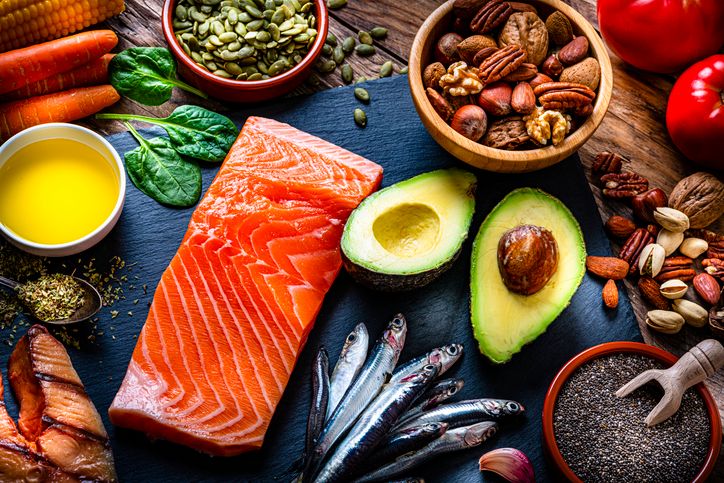
Healthy fats help control hunger and support digestion
Healthy fats can support GLP-1 response by slowing digestion and helping you feel full after meals. They also provide lasting energy and help regulate blood sugar levels. Foods like avocados, nuts, and olive oil offer the right type of fat for steady appetite control and balanced eating.
Avocados support fullness and blood sugar balance
Avocados are rich in monounsaturated fats and fiber—two key nutrients that support slow digestion and fullness. One avocado contains around 13 grams of healthy fats and 10 grams of fiber. These nutrients work together to slow the rate at which food leaves the stomach, supporting steady energy and reducing the urge to snack.
They also help manage blood sugar levels and reduce bloating, thanks to their potassium content. Try adding half an avocado to breakfast or lunch. Its creamy texture works well in salads, on whole grain toast, or blended into smoothies.
Nuts offer a mix of protein, fiber, and fat for steady energy
Nuts such as almonds, walnuts, pistachios, cashews, or macadamias are protein-rich foods that support satiety. Their fiber content slows digestion, while their healthy fats help lower blood sugar spikes after eating.
This makes them a smart choice for between-meal snacks. A one-ounce serving can keep you satisfied for hours. Nuts also provide important nutrients like magnesium and vitamin E, which support metabolism and overall health.
Olive oil helps activate satiety hormones
Extra virgin olive oil contains monounsaturated fats that support GLP-1 hormone activity. These fats slow down digestion and trigger satiety signals that help control portions and reduce cravings.
Olive oil also supports gut health, thanks to its anti-inflammatory properties. Aim for 1 to 2 tablespoons per meal. You can use it in dressings, over roasted vegetables, or drizzled on lean proteins to improve both flavor and fullness.

GLP-1 Weight Loss Food 4: Complex Carbohydrates That Help Stabilize Blood Sugar
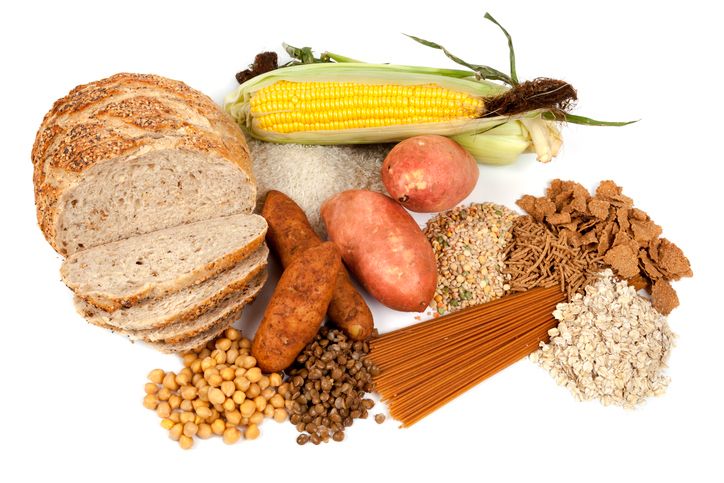
Complex carbs support steady energy and digestion
Complex carbohydrates digest more slowly than refined carbs. This slower process supports GLP-1 release, helping you feel full longer and avoid sharp changes in blood sugar. Choosing fiber-rich carbohydrates like whole grains, legumes, and sweet potatoes can help support better blood sugar control and appetite regulation.
Whole grains digest slowly and reduce blood sugar spikes
Whole grains contain all parts of the grain—bran, germ, and endosperm—which provide fiber, protein, and key vitamins. These nutrients work together to slow digestion and lower the glycemic impact of a meal.
Examples include brown rice, quinoa, oats, and whole wheat. These foods help reduce the chance of sudden hunger by promoting slow and steady energy release. Refined carbs like white bread or white rice, by contrast, digest quickly and often lead to cravings and blood sugar crashes.
Replacing refined grains with whole grains is a simple change that supports GLP-1’s effects and helps with better food choices throughout the day.
Sweet potatoes offer fiber and steady fuel
Sweet potatoes are a nutrient dense source of complex carbs. They are high in fiber and naturally low on the glycemic index, which makes them ideal for maintaining stable blood sugar levels and supporting GLP-1 release.
They also provide beta-carotene, potassium, and vitamin C, supporting your overall health during weight loss. Leaving the skin on adds extra fiber. Try roasting or steaming sweet potatoes as part of a meal. You can pair them with lean protein or healthy fats to further support slow digestion and fullness.
Legumes improve GLP-1 response and glucose control
Legumes such as lentils, chickpeas, and beans contain both protein and complex carbohydrates. This makes them especially effective at helping to manage blood sugar while keeping you full.
They support digestion in several ways:
• Fiber slows how quickly food moves through the small intestine
• Protein helps trigger GLP-1 releas
• Soluble fiber feeds gut bacteria that may help maintain proper GLP-1 levels
You can add legumes to salads, soups, or use them as meat substitutes in meals. They support your weight loss goals by improving satiety, lowering blood sugar, and helping reduce total calorie intake naturally.
Book Now to Experience
S6 Body Sculpting Treatment
1 Minute Self-Registration
Date should not be before minimal date

GLP-1 Weight Loss Food 5: Probiotic-Rich Foods That Support Digestive Health
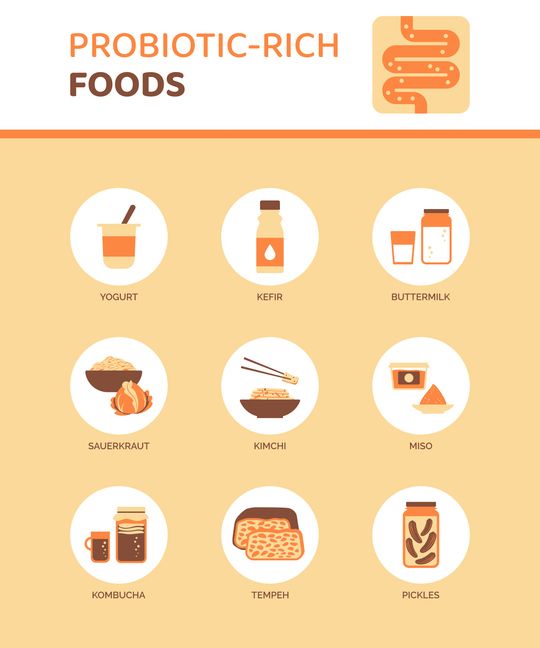
Probiotics help balance gut bacteria and support appetite control
Probiotic-rich foods play an important role in supporting digestive health, especially while following a GLP-1 based diet. A healthy gut helps regulate hunger hormones and improves how your body responds to food. Including fermented foods in your eating habits may also enhance how well your body responds to GLP-1 medications.
These foods help maintain a strong gut barrier, reduce inflammation, and support smoother digestion—factors that can influence your ability to manage weight and maintain regular energy.
Common probiotic foods and their benefits
Including a few servings of these foods in your weekly meal plan can help support gut balance and improve digestion during your weight loss journey:
Yogurt and kefir
These dairy-based options are both high in probiotics. They help support digestion and may reduce inflammation in the gut. Choose plain, unsweetened varieties to avoid added sugar that could interfere with blood sugar control.
Kimchi and sauerkraut
These fermented vegetables contain beneficial bacteria that aid nutrient absorption and support immune function. They also add flavor and crunch to meals without increasing calorie intake.
Kombucha and miso
Kombucha is a fermented tea, while miso is a fermented soybean paste used in soups and sauces. Both provide live cultures that may help strengthen the gut lining and reduce bloating.
Start with small portions of these foods and gradually increase intake to avoid digestive discomfort. Probiotics can complement GLP-1 medications and support better appetite regulation and weight management when included as part of a balanced diet.

GLP-1 Weight Loss Food 6: Spices and Herbs That Support Metabolism
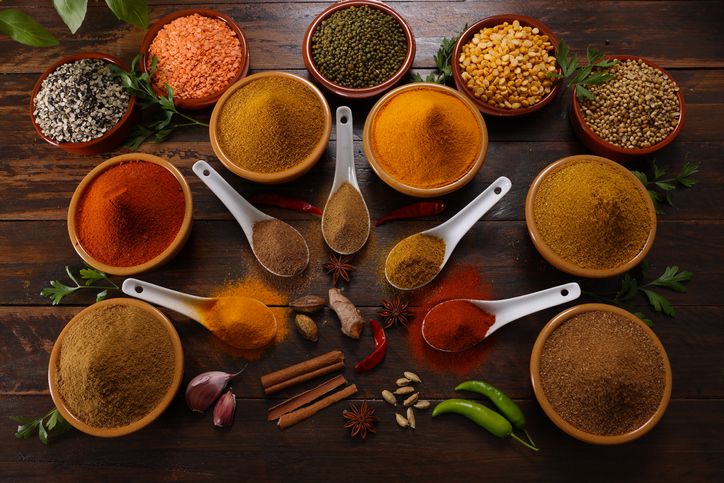
Certain spices help increase calorie burn and reduce cravings
Spices and herbs can support weight loss by enhancing metabolism and regulating blood sugar. These natural additions don’t just improve flavor—they also work with your body’s GLP-1 response. Some spices may slightly increase thermogenesis, a process where your body burns more calories to generate heat.
Adding these ingredients to your meals can support appetite control, improve digestion, and help manage eating habits throughout the day.
Spices that support GLP-1 function and fat burn
Cayenne pepper and chili flakes
These spices contain capsaicin, a compound that may increase calorie burn after meals. They can also help reduce appetite, supporting smaller meals and fewer cravings.
Ginger and turmeric
Both have anti-inflammatory properties and support healthy digestion. They may also improve gut function, which is important for maintaining proper GLP-1 activity.
Cinnamon
Cinnamon helps stabilize blood sugar levels and may reduce cravings for sugary foods. It’s easy to add to oatmeal, yogurt, or smoothies as part of a healthy diet.
Start with small amounts if you’re not used to these spices. Regular use can support your GLP-1 medication and contribute to better weight management through improved digestion and more stable blood sugar levels.
Book Now to Experience
S6 Body Sculpting Treatment
1 Minute Self-Registration
Date should not be before minimal date

GLP-1 Weight Loss Food 7: Low-Glycemic Fruits That Satisfy Without Spiking Blood Sugar

Low-glycemic fruits provide natural sweetness and stable energy
You don’t need to avoid fruit completely while following a GLP-1 based meal plan. The key is choosing fruits that won’t cause rapid blood sugar spikes. Low-glycemic fruits digest more slowly, support appetite control, and fit well into a balanced diet focused on weight management.
These fruits provide fiber, water, and antioxidants, making them nutrient dense foods that can help you feel full without adding too many calories.
Best fruits for blood sugar support and weight loss
Berries
Strawberries, blueberries, raspberries, and blackberries are among the best foods for stable blood sugar. They are rich in fiber, low in sugar, and packed with important nutrients that support overall health.
Green apples, grapefruit, and kiwi
These fruits are low on the glycemic index and contain fiber that slows sugar absorption. They also support digestive health and can help reduce cravings throughout the day.
Cherries, peaches, and plums
In smaller portions, these fruits can satisfy sweet cravings without overwhelming your system. They offer flavor, vitamins, and hydration with fewer calories than sugary snacks.
For best results, pair fruit with protein or healthy fats—like nuts or Greek yogurt—to slow digestion even further and keep blood sugar steady. This supports your GLP-1 response and helps you stay satisfied between meals.

GLP-1 and Meal Timing: How Eating Patterns Affect Appetite and Fat Loss

Smaller, balanced meals support GLP-1 response
In addition to choosing the right foods, the way you space your meals can affect how well your body responds to GLP-1. Eating smaller, well-balanced meals throughout the day can support more stable blood sugar levels, prevent energy crashes, and reduce the urge to overeat. This structure also gives your digestive system time to release GLP-1 gradually, keeping hunger in check.
Eating three meals per day with one or two protein-rich snacks is often more effective than skipping meals or waiting too long between them. This helps your body maintain muscle mass while supporting appetite control.
Frequent meals help with energy and digestion
Spacing meals 3 to 5 hours apart may help keep blood sugar stable, especially when each meal contains a mix of lean protein, healthy fats, fiber, and complex carbs. Frequent meals also support proper nutrition by making it easier to meet your daily nutritional needs without overeating at any one time.
If you're taking a GLP-1 medication, your appetite might naturally decrease. That makes it even more important to choose nutrient dense foods during each eating window to avoid falling short on calories, protein, or important nutrients.
Building a GLP-1 friendly meal plan
A simple meal plan could include:
• Breakfast with protein (like eggs or Greek yogurt), healthy fats (such as avocado), and fiber (berries or oats)
• A high-protein lunch with lean meats, green vegetables, and complex carbs
• A light afternoon snack like nuts or cottage cheese
• A dinner that includes legumes, steamed vegetables, and a small portion of brown rice
This kind of balanced diet supports digestion, appetite control, and blood sugar stability—all of which help make your weight loss journey more manageable and effective.
Book Now to Experience
S6 Body Sculpting Treatment
1 Minute Self-Registration
Date should not be before minimal date

Supporting Fat Loss with S6 Body Sculpting Treatment
Combine targeted treatments with proper nutrition for better results
Even with a structured meal plan built around GLP-1 weight loss foods, some areas of the body are slower to respond. Fat stored around the belly, arms, or thighs can be more resistant, especially if your activity levels are limited or your metabolism has slowed down over time.
S6 Body Sculpting Treatment offers a practical solution. This non-invasive therapy uses low-energy bio-laser and vacuum suction to target fat in specific areas, helping improve your body shape without surgery or downtime. It's a simple way to support your weight loss progress—especially when combined with healthy eating and regular movement.
How the treatment works
The S6 system uses a patented bio-laser to penetrate deep into subcutaneous fat layers. This process breaks down fat cells by triggering the release of fatty acids, which are then cleared through lymphatic drainage. Vacuum suction follows each laser application, helping stimulate blood flow and improve metabolism in the targeted zone.
The treatment also helps firm and tone the skin by encouraging natural collagen production, making it especially useful for people concerned about sagging after fat loss. It can be used on common problem areas like the belly, thighs, buttocks, back, and arms—areas where diet changes alone may not be enough.
Benefits of pairing GLP-1 nutrition with body contouring
• Targets fat that’s resistant to diet and exercise
• Boosts local metabolic activity for faster fat processing
• No surgery, injections, or downtime
• Firms skin while reducing fat
• Complements muscle-preserving efforts from high-protein diets and strength training
If you’re eating GLP-1 weight loss foods, focusing on smaller meals, and trying to preserve muscle mass while losing weight, this treatment can help fine-tune your results—especially in areas where fat tends to linger.
Book your S6 Body Sculpting session today and take your weight loss journey one step further.
New Beauty's S6 Body Sculpting Treatment
Food Interactions While Taking a GLP-1 Medication

Certain eating habits can affect how well GLP-1 medications work
When taking a GLP-1 for weight loss, your food choices can either support or interfere with the medication’s effects. GLP-1 medications work by slowing digestion, lowering blood sugar levels, and helping you feel full faster. Eating habits that align with these effects can improve how your body responds to the treatment.
Foods that digest slowly—like high-fiber vegetables, lean protein, and healthy fats—support the medication by extending gastric emptying and controlling appetite. On the other hand, foods that are high in sugar or refined carbs may cause blood sugar spikes that go against the stabilizing effects of the drug.
What to avoid while taking a GLP-1
To get the best results, limit or avoid:
• Sugary foods like soft drinks, candy, and desserts
• Refined carbohydrates such as white bread, white rice, and regular pasta
• High fat foods that are deep-fried or heavily processed
These can overwhelm your digestive system, increase the risk of nausea or bloating, and reduce the medication’s ability to lower blood sugar efficiently.
When and how to eat while using GLP-1
Eating smaller meals throughout the day helps reduce digestive discomfort and supports stable energy levels. Since GLP-1 medications slow how fast food leaves your stomach, large meals can feel heavy and cause bloating. Instead, choose three smaller meals or divide your food into four or five lighter portions.
Pair each meal with lean protein, fiber, and healthy fats to support satiety and maintain muscle mass. Staying hydrated and avoiding long gaps between meals can also prevent nausea or dizziness—common early side effects of GLP-1 medications.
By following these eating strategies alongside your treatment, you can better manage your weight, improve digestion, and keep blood sugar levels more stable.
Book Now to Experience
S6 Body Sculpting Treatment
1 Minute Self-Registration
Date should not be before minimal date
FAQ
1. Can I eat fewer calories and still get enough nutrition on a GLP-1 weight loss plan?
Yes, it’s possible to eat fewer calories while still meeting your nutritional needs if you focus on nutrient dense foods. These include lean protein, healthy fats, whole grains, and high-fiber vegetables. These foods help manage blood sugar levels, support proper nutrition, and reduce the risk of muscle loss—especially when your appetite is reduced due to GLP-1 medications.
2. Is it safe to take GLP-1 medications and follow a high-protein diet?
In most cases, yes. High-protein diets can help you maintain muscle mass while losing weight, which is important when using GLP-1 medications that suppress appetite. Protein rich foods also support slower digestion and help reduce cravings. However, if you're on other medications or have kidney issues, it's best to consult a registered dietitian or healthcare provider.
3. Do I need to avoid all high fat foods while taking a GLP-1?
Not all high fat foods need to be avoided. The key is choosing healthy fats, such as those from avocados, nuts, seeds, and olive oil. These fats support fullness, slow digestion, and help lower blood sugar when eaten in moderation. Avoiding trans fats and limiting deep-fried or overly processed foods is more important than cutting fat completely.
4. How do GLP-1 weight loss foods help improve digestion?
GLP-1 friendly foods support digestion in several ways. Fiber-rich foods like leafy greens and legumes slow down how quickly food moves through the small intestine, helping to stabilize blood sugar and promote satiety. Probiotic-rich foods also help maintain a balanced gut microbiome, which plays a role in digestion and overall health.
5. Can I still eat three meals a day while taking GLP-1 medication?
Yes, you can eat three meals a day, but meal size and structure might need adjusting. Many people find that smaller meals with enough calories and high nutritional quality work better. Eating smaller, frequent meals can help prevent blood sugar dips and maintain steady energy levels—especially when your appetite is reduced. Pairing each meal with a lean protein source and fiber can support both satiety and digestion.
Recommended Articles
COPYRIGHT© NEW BEAUTY MANAGEMENT LIMITED 2025. ALL RIGHT RESERVED.




